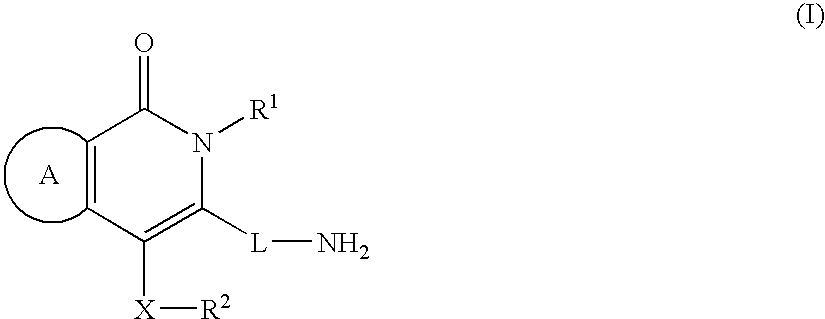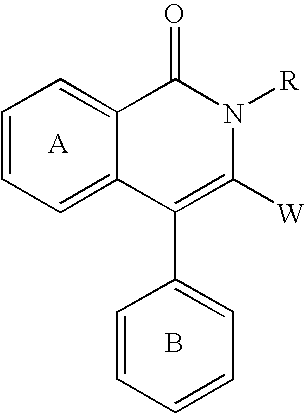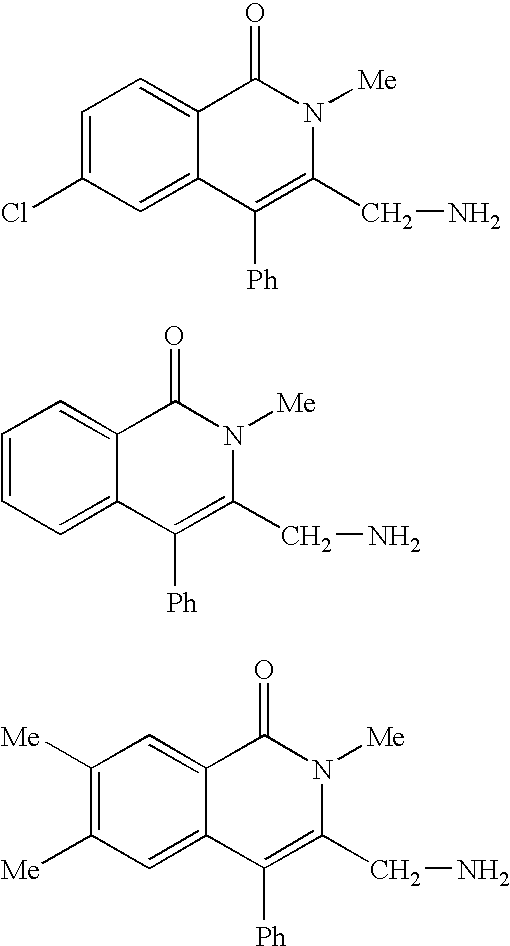Fused heterocyclic compounds
a heterocyclic compound and compound technology, applied in the field of fused heterocyclic compounds, can solve the problems of lactic acidosis, a relatively serious side effect, and serious hypoglycemia that requires attention during use, and achieve the effect of peptidase in the report of these compounds
- Summary
- Abstract
- Description
- Claims
- Application Information
AI Technical Summary
Problems solved by technology
Method used
Image
Examples
example 1
3-(Aminomethyl)-4-butoxy-6-ethoxy-2-neopentyl-1(2H)-isoquinolinone hydrochloride
[0654](1) A solution of 4-fluorophthalic anhydride (8.31 g, 50 mmol) and ethyl 2-(neopentylamino)acetate (10.40 g, 60 mmol) in tetrahydrofuran (50 ml) was stirred at room temperature for 1 h. The reaction mixture was poured into water and extracted with ethyl acetate. The extract was washed with brine, dried over anhydrous magnesium sulfate and concentrated under reduced pressure. The residue was dissolved in N,N-dimethylformamide (50 ml), and potassium carbonate (6.91 g, 50 mmol) and ethyl iodide (4.8 ml, 60 mmol) were added. The mixture was stirred at room temperature for 3 h. The reaction mixture was poured into water and extracted with ethyl acetate. The extract was washed with brine, dried over anhydrous magnesium sulfate and concentrated under reduced pressure. The residue was dissolved in ethanol (50 ml) and 20% sodium ethoxide ethanol solution (34.04 g, 100 mmol) was added. The mixture was stirre...
example 2
3-(Aminomethyl)-4-butoxy-7-fluoro-2-neopentyl-1(2H)-isoquinolinone hydrochloride
[0672](1) To a solution of ethyl 7-fluoro-4-hydroxy-2-neopentyl-1-oxo-1,2-dihydro-3-isoquinolinecarboxylate (5.12 g, 31.9%) (from Example 1(1), 3.21 g, 10 mmol), 1-butanol (1.4 ml, 15 mmol) and tributylphosphine (5.0 ml, 20 mmol) in tetrahydrofuran (30 ml) was added 1,1′-(azodicarbonyl)dipiperidine (5.05. g, 20 mmol) and the mixture was stirred at room temperature for 3 h. The reaction mixture was concentrated, under reduced pressure and the residue was purified by silica gel column chromatography to give ethyl 4-butoxy-7-fluoro-2-neopentyl-1-oxo-1,2-dihydro-3-isoquinolinecarboxylate (3.55 g, 94.2%) as an oil.
[0673]1H-NMR(CDCl3) δ: 0.94 (9H, s), 1.01 (3H, t, J=7.1 Hz), 1.44 (3H, t, J=7.1 Hz), 1.51–1.63 (2H, m), 1.73–1.87 (2H, m), 3.95 (2H, t, J=6.4 Hz), 4.11 (2H, bs), 4.43 (2H, q, J=7.1 Hz), 7.40–7.50 (1H, m), 7.79 (1H, dd, J=5.2, 8.8 Hz), 8.09 (1H, dd, J=2.8, 9.4 Hz).
[0674](2) To a solution of 4-butoxy-...
example 3
3-(Aminomethyl)-4-butoxy-6-fluoro-2-neopentyl-1(2H)-isoquinolinone hydrochloride
[0686](1) To a solution of 4-butoxy-6-fluoro-3-hydroxymethyl-2-neopentyl-1(2H)-isoquinolinone (from Example 1(3), 1.68 g, 5 mmol) in tetrahydrofuran (10 ml) and toluene (10 ml) was added thionylchloride (0.73 ml, 10 mmol), and the resulting mixture was refluxed under heating for 2 h. The reaction mixture was poured into saturated aqueous sodium hydrogencarbonate solution and extracted with ethyl acetate. The extract was washed with brine, dried over anhydrous magnesium sulfate and concentrated under reduced pressure to give 4-butoxy-6-fluoro-3-chloromethyl-2-neopentyl-1(2H)-isoquinolinone (1.62 g, 92.0%) as an oil.
[0687]1H-NMR(CDCl3) δ: 0.98 (9H, s), 1.04 (3H, t, J=7.4 Hz), 1.51–1.69 (2H, m), 1.81–1.95 (2H, m), 3.94 (2H, t, J=6.6 Hz), 4.17 (2H, bs), 4.87 (2H, bs), 7.12–7.30 (1H, m), 7.35 (1H, dd, J=2.6, 9.6 Hz), 8.09 (1H, dd, J=5.8, 9.0 Hz).
[0688](2) A solution of 4-butoxy-6-fluoro-3-chloromethyl-2-neope...
PUM
| Property | Measurement | Unit |
|---|---|---|
| Molar density | aaaaa | aaaaa |
| Molar density | aaaaa | aaaaa |
| Molar density | aaaaa | aaaaa |
Abstract
Description
Claims
Application Information
 Login to View More
Login to View More - R&D
- Intellectual Property
- Life Sciences
- Materials
- Tech Scout
- Unparalleled Data Quality
- Higher Quality Content
- 60% Fewer Hallucinations
Browse by: Latest US Patents, China's latest patents, Technical Efficacy Thesaurus, Application Domain, Technology Topic, Popular Technical Reports.
© 2025 PatSnap. All rights reserved.Legal|Privacy policy|Modern Slavery Act Transparency Statement|Sitemap|About US| Contact US: help@patsnap.com



